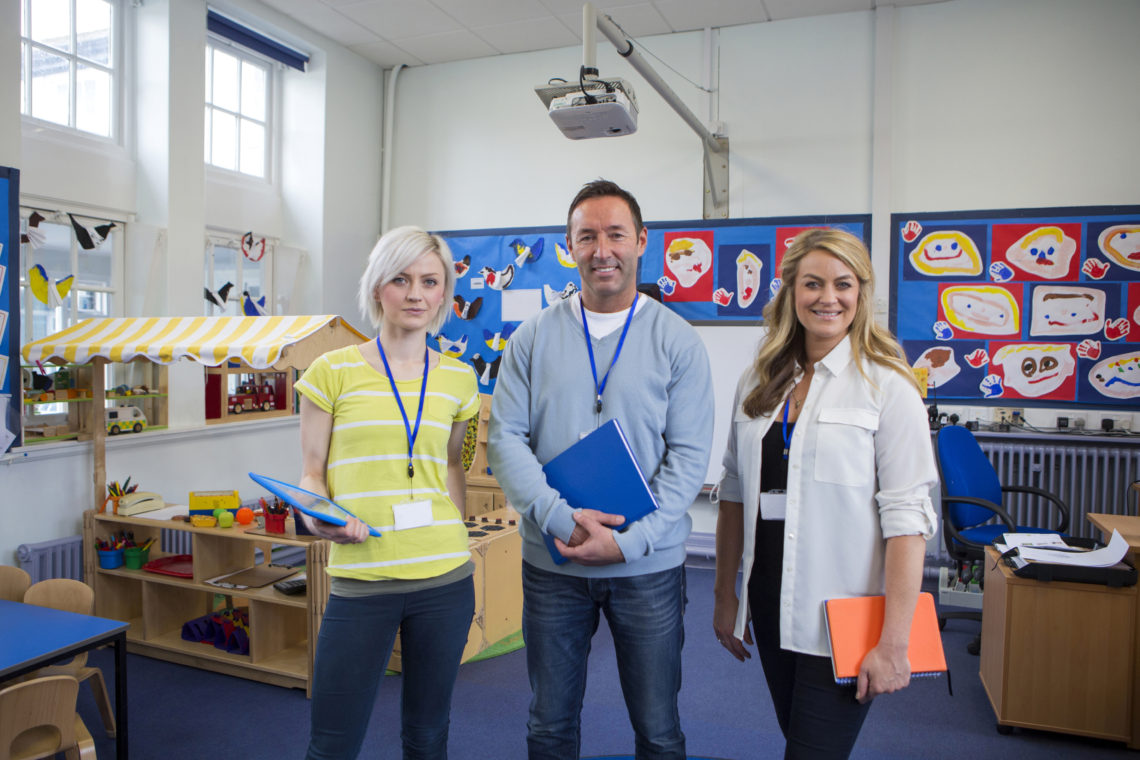
6 Effective Co-Teaching Models, and When to Use Them
Co-Teaching seems to be the trend for public schools. My school, like many others, is leaning towards a model that includes as many students as possible into the general education classroom. To make this work, many special education teachers are expected to co-teach.
General education inclusion classes with the content area teachers to provide the necessary modifications and accommodations to the students on my caseload. In the meantime, there are great peer models coming from the general education population.
Also, there is less of a stigma placed on students with disabilities because they are not being removed from the classroom. This concept makes it more difficult to determine which students are on IEPs and which teachers are special education teachers.
My story is, I am an eighth-grade special education inclusion teacher. I began working in my position in January of 2015 (right before the snow-maggedon!) Currently, I co-teach two pre-algebra classes, one geometry class, and one ELA class. Unfortunately, my students are expected to take two math classes per day, causing a lot of frustration for students who are struggling with math. I am in my third school year with the ELA teacher and the pre-algebra teacher; this is my first year having a spot in my schedule to support my students in geometry also.
I have developed a great co-teaching relationship with the two teachers that I have worked with for three years, and I am developing a good relationship with the teacher I have just begun co-teaching with. But, all three relationships are a work in progress. Every year I feel like things get a little smoother as we get more comfortable with each other, and as I get more comfortable with the curriculums.
Team Teaching
Team Teaching is when two teachers are simultaneously teaching content together in the classroom. Many consider this the most effective form of co-teaching, but it is also the most time-consuming. And for many of us, we do not consistently have the time appropriate for effectively instituting team teaching every day. If you walk into a classroom where team teaching is happening, ideally you would not be able to tell the roles of the individual teachers. You would not be able to distinguish which teacher was the special education teacher and which was the content area teacher. There may be slight evidence based upon which teacher is giving input on specific strategies and reiterating things v. which teacher seems to be stronger with the content, but for the most part, they are hard to tell apart.
Team teaching is great for lessons that involve lecturing. It is great for most situations.
Pros
This proves to be the most seamless version of co-teaching. Both teachers are interchangeable and receiving equal respect. Both teachers are working with all students so that all students are receiving the benefits of both teachers’ expertise. This type of teaching is referred to in many articles as “tag-team” teaching. This type of co-teaching is most likely going to have the best differentiation because of the amount of time spent co-planning.
Cons
The difficulty with this type of co-teaching is the amount of time it requires to work appropriately. I feel like it is all of our goals. But without proper co-planning time, it is near impossible. It is also difficult for a special education teacher that is working with more than one general education teacher because it requires an extensive amount of time planning with two different teachers
I get plenty of planning time with the ELA teacher that I co-teach with.
But on the other hand, I get no dedicated planning time for me and the math teacher that I co-teach with. After three years of working together, and the fact that math is my strength, we are now to a point where we can team teach in a very minimalistic way. Ideally, I would be provided co-planning time with both of my co-teachers to be able to team teach with both of them. For the third teacher that I have just begun a co-teaching relationship with this year, we get zero planning time and have no experience working as co-teachers so team teaching is near impossible.
Parallel Teaching
In parallel teaching, both teachers are teaching the same content simultaneously. There is no specification as to whether or not this has to be done in the same room, but I feel as though with how full our classes are these days, it would be difficult having two teachers teach simultaneously and difficult for the students to be able to focus on one specific teacher.
When I use parallel teaching we split the kids into two heterogeneous groups and I bring my group to my classroom and the general education teacher keeps the rest of the kids in her classroom. We discuss ahead of time what the assignments are going to be and so both groups are given the same classwork and the same homework. The only difference with how we do this is my group is always a little smaller, but that is just because of the available space in my small office. I can only comfortably seat 8-10 students and this is less than half.
Parallel teaching is a great model to use when you are introducing a new subject.
Pros
The benefit of parallel teaching is that there are smaller groups of students. Instead of teaching a class of 30, you are now teaching a class of 15. Having smaller groups leads to the students being more comfortable asking questions. Also, it allows the teacher to have a smaller group to focus on and be able to spend more time working individually with each student.
Cons
Both teachers need to be equally comfortable with the content for this to work appropriately. To be honest, there are still things that we do in ELA that I am not sure I would be entirely comfortable teaching without the general education teacher available to answer questions that may stump me or clarify things. Personally, I am always more confident in math as I have been a “math person” since I was in school myself. Therefore, I utilize this co-teaching model in math more often than I do with my ELA classes.
Station Teaching
Station teaching is when you are running two or more stations at a time. In this model, you would multiple stations running with each teacher responsible for a station. Any other stations would be something the students would be working independently. This model can be used for remediation, working on multiple skills simultaneously, or just to provide more differentiated instruction and activities.
Use station teaching when you want to support different levels of students and work on different skills.
Pros
This model is great because of the freedom it provides to be able to identify and work on specific skills. The more groups that you have, the smaller the groups will be and that will allow teachers to pay attention to more specific needs and finding error patterns or deficits. With this model, you can utilize different teachers’ strengths and weaknesses. This really lends itself to being able to differentiate, not every group needs to do the same thing at each station. Your stronger groups can do enrichment activities, while your groups that are still struggling can receive remediation.
Cons
The difficulty with this is you need to make sure you have excellent classroom management. Students who are working in a group that does not have a teacher assigned to it need to be working independently and not causing problems. Every time you have to step away from the group that you’re working with to address an issue with another group, you are taking away from the group that you are supposed to be working with.
One Teach / One Support
This is the model of co-teaching that I see the most. One teacher, usually the content area teacher, is up at the front of the room teaching the class. Meanwhile, the other teacher is roaming through the room checking on kids and addressing specific questions quietly and individually.
This is great for introducing a new topic, reviewing answers to homework or other assignments. This is also great for co-teachers who are just beginning their relationship. It gives them time to get used to the other’s teaching style or to allow the general education teacher to get more comfortable with the content.
Pros
One teach – one support allows for students to receive individual attention without taking away from the rest of the students in the room. A student who is still stuck can receive individual attention. Meanwhile, the classroom teacher is still teaching the rest of the class. This method of co-teaching requires minimal planning time, as the supporting teacher has little prep to do before the lesson. Not having planning time is not ideal for a co-teaching relationship. But, sometimes there are things that get in the way of proper co-planning. Also having a teacher circulating around the room can be beneficial for classroom management. Be cautious with this though, check out my blog post about the pros and cons of teacher proximity.
Cons
The circulating teacher needs to be careful that you are not spending too much time with specific students. This can cause the student to be identified by their classmates and possibly made fun of.
One Teach / One Observe
In this model, one teacher is teaching the class while another teacher is observing the class. Usually, this means that the second teacher is not interacting with the students unless necessary.
This model is best used when it is necessary to take data. I have used this model when trying to complete a functional behavior assessment (FBA) on a student. Or, I need to take behavioral data for their IEP goals.
Pros
This model frees up one of the teachers to observe the students and record pre-determined data. This model should be used rarely during special times.
Cons
This model is not great for regular co-teaching because one of the teachers is not interacting with the lesson at all.
Alternative teaching
Alternative teaching is when one teacher takes control of the majority of the class. While this is happening, the second teacher takes a small group of students to work on remediation.
This model should be used when it has been identified that there is a group of students who are falling behind. This model can also be used to introduce a new topic when you anticipate some students needing more direct and explicit instruction.
Pros
This model allows students to be given remediation while not holding the rest of the class back. In normal situations, having to go back and review skills causes the students who are not struggling to become bored. Bored students can lead to classroom management problems. Pulling the group of students who need remediation to another setting to get it allows the teacher with the larger group to work on enrichment activities or focus on higher-level thinking.
Cons
This type of co-teaching can cause social stigmas if you are not careful. If the students understand what is happening, they may end up getting picked on by their peers.
Conclusion
There are more models of co-teaching that I have not mentioned. I am discussing the six that I see the most and that I am the most familiar with. If there are great co-teaching models that I haven’t mentioned, please tell me about them in the comments! I am always looking for more ideas.
Also, check out:
A Beginners Guide to Inclusion
FREE co-teaching checklist

Subscribe to receive a free co-teaching checklist!







